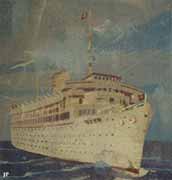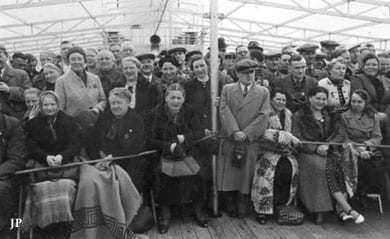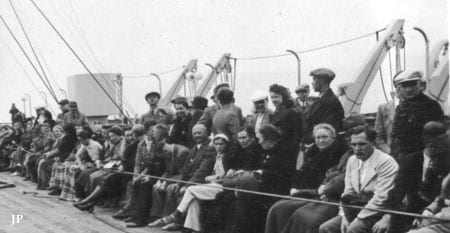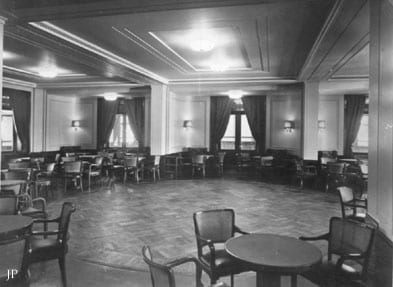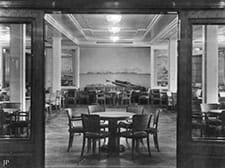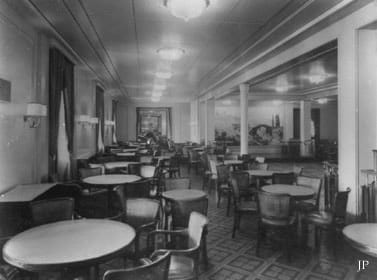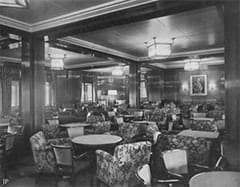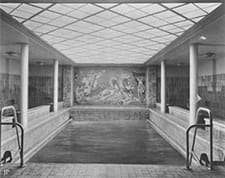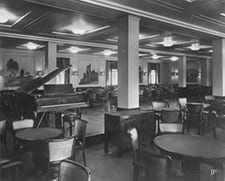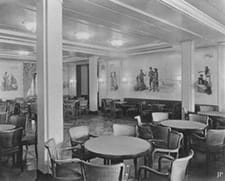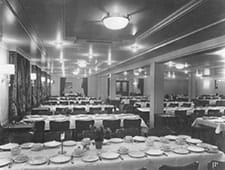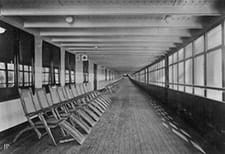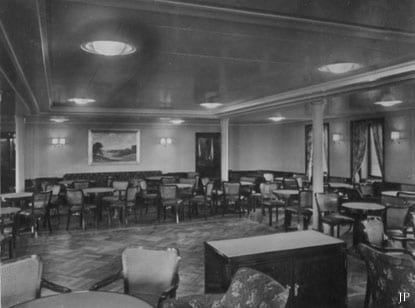A Memorial To The Wilhelm Gustloff
Wilhelm Gustloff as Lazarettschiffe D On the bitterly cold night of January 30th, 1945, the former KdF Cruise Liner Wilhelm Gustloff, at the time serving as a barracks ship for the Kriegsmarine, left from the Baltic port of Gotenhafen and set sail for the relative safety of the west, away from the advance of Soviet forces that were converging on the region. The Gustloff, designed to carry a maximum of 1,865 people total, was transporting 10,582refugees, soldiers, sailors, and crew – including scores of sick and injured, as well as women, children, and the elderly. All were fleeing from the terrible fate that awaited most of those left in the wake of the Soviet advance, including Germans and non-Germans alike. When the gray light of dawn lifted over the freezing cold waves of the Baltic Sea on January 31st, 1945, it would fail to fall upon the decks of the Gustloff, for that night it had been sunk by the Soviet sub S-13 and disappeared under the dark sea in less than 50 minutes, taking with it 9,343 lives, marking its loss as the most tragic naval loss in all of history. 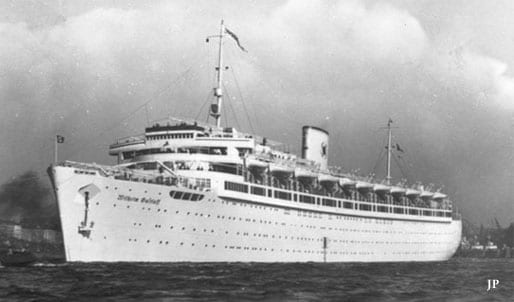 The Wilhelm Gustloff (25484 BRT) was launched in 1937 as the crown jewel of the Kraft durch Freude or Strength through Joy organization (KdF). The KdF was a subgroup of the Deutsche Arbeitsfront or German Labor Front (DAF). The DAF had been organized in place of unions that had been banned by the NSDAP. The DAF had as its goal the control and direction of the entire German labor force, and the KdF was used as a means towards this end by providing activities such as trips, cruises, concerts, and cultural activities. These events were specifically directed towards the working class and it was through the KdF that the NSDAP hoped to bring to the “common man” the pleasures once reserved only for the rich. By opening the door for the working class to easily and affordably take part in activities once reserved only for the rich, it was hoped that the labor force could be lulled into being more flexible and productive. 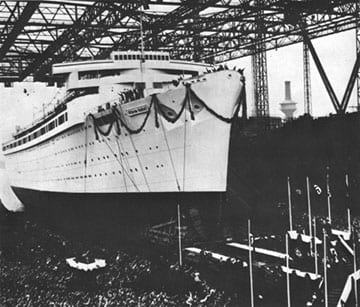 The Wilhelm Gustloff was named after a man considered by some during the time to be a German martyr. Wilhelm Gustloff had been the leader of the NSDAP in Switzerland and he was assassinated in 1936. His name was chosen for the largest liner of the KdF fleet and in 1937when it was launched, his widow christened the bow on its maiden voyage. The Gustloff was launched as the flagship for the entire KdF fleet, of which there were a great number of ships both large and small, many of which would go on to experience similar stories during WWII.  For nearly two years after it was launched the Wilhelm Gustloff sailed on pleasure cruises in the Atlantic Ocean and the Mediterranean and North Seas. Then in May of 1939, four months before WWII began, the Gustloff took part in a slightly different role. Alongside five other ships, the Robert Ley, the Deutsche, the Stuttgart, the Sierra Cordoba, and the Oceana, (the first four ships of the KdF fleet), the Gustloff took part in transporting back to Germany the Legion Condor from Spain. These men were being brought home after the successful defeat of the Republican forces by Franco’sNationalists. The Gustloff, along with other ships of the transport fleet, arrived in Vigo, Spain on May 24th, 1939, and unloaded large amounts of medical supplies and other materials that were given to the Spanish Social Help organization. On May 26th, 1939 the members of the Legion were loaded on the ships in Vigo harbor, with the Gustloff taking on 1,405 men. On May 30th, 1939 the ships arrived in German waters and were escorted into the Port of Hamburg by a parade of vessels including the yacht Hamburg, Panzerschiffe Admiral Graf Spee, and Panzerschiffe Admiral Scheer.
On September 22nd, 1939, shortly after the Second World War broke out, the Wilhelm Gustloff was officially commissioned into the Kriegsmarine by the German Armed Forces for use as a hospital ship. It was classified as Lazaretschiff D, or Hospital Ship D. Lazaretschiffe in the German Armed Forces served as floating hospitals for the sick and wounded, and as with many other nations during the period, their use was strictly monitored and followed a specific set of international procedures for their employment. Depending on their intended region of use, they were required to be painted entirely white, with the inclusion of a green band running the length of the ship on all sides and various red cross markings on the deck, stacks, and sides. They were also prohibited from carrying any form of offensive or defensive weapons. It was in this role that the Gustloff would first enter WWII. The first employment of the Gustloff as Lazaretschiff D was in Danzig-Neufahrwasser at the end of the Polish Campaign. The first wounded taken on board were 685 soldiers from the defeated Polish Army. The Gustloff went on to serve in the Danzig Bay region for the next many weeks, later taking part in relief operations for the thousands of Baltic Germans that were being moved from regions recently brought under the control of the Soviets, back to Germany or to areas controlled by Germans. The Gustloff took part in this operation alongside a number of other former KDF ships such as the Stuttgart, Der Deutsche, Robert ley, and the Oceana. From May of 1940 until July of the same year, the Gustloff was on station in Norway in Oslo as a floating hospital for the sick and wounded from the Norwegian Campaign. The Gustloff left Oslo and headed for Stettin on July 2nd, 1940, carrying on board 563 wounded. During the late summer and early fall of 1940, the Gustloff was ordered to prepare for operations during the planned Invasion of England, which eventually were canceled in late summer 1940. Once more, on October 20th, 1940, the Gustloff sailed again to Oslo and took on 414 wounded for transport back to Swinemünde. Shortly after this trip, the Gustloff was to end its service as a Lazarettschiffwhen it was directed that it move to Gotenhafen for service as a barracks ship for the U-boot arm of the Kriegsmarine. From September 22nd, 1939 until November 20th, 1940, the Gustloff took on a total of 3,151 wounded and sick, and over the course of four trips, transported1,961 wounded back to Germany. 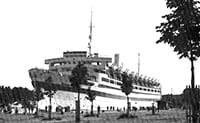 As a Wohnschiff (barracks ship) of the Kriegsmarine, under the control of the 1.Unterseeboots-Lehrdivision, and later the 2.Unterseeboots-Lehrdivision, the Gustloff lay at anchor in Gotenhafen, its new resting place, for over four years. Then, in January of 1945, the Gustloff was once more put into service, this time as apart of the largest planned naval evacuation operation in history, the rescue, and transport of millions of refugees, soldiers, sick, injured and others fleeing from the advance of the Soviet forces in the east. Nearly all of the former KdF liners, along with many other freight and cargo ships, naval auxiliaries, and even combat vessels, took part in this massive rescue operations. Of the largest ships that took part were the liners and passenger ships, which mostly, like the Gustloff, were until then being used as barrack and accommodation ships in either Danzig, Pillau, or Gotenhafen. The largest ships were the following: Cap Arcona (27561), Robert Ley (27288), Hamburg (22117), Hansa (21131), Deutschland (21046), Potsdam (17528), Pretoria (16662), Berlin (15286), General Steuben (14660), Monte Rosa (13882), Antonio Delfino (13589), Winrich von Kniprode (10123), Ubena (9554), and the Goya. At the end of the War, the operation proved to be a huge success, in light of the crushing and total defeat of Germany, in so far that over 2,000,000 people were rescued from areas of the Soviet advance. Had these 2,000,000 refugees not been rescued, as has been well documented elsewhere (As in the volumes “Documents on the Expulsion of the Germans from Eastern-Central-Europe), the plight of many of the refugees was likely to have been grim. Out of the total number rescued, about 25,000 to 30,000lives were lost, the majority with the sinking of the Gustloff and the Goyawith a combined total of over 15,000 deaths. Considering the number of people transported and the conditions and time of the transport (January – May 1945), the number of lives lost versus the number rescued remains to this day a stark reminder of the size, scope, and determination of the massive German sea rescue. 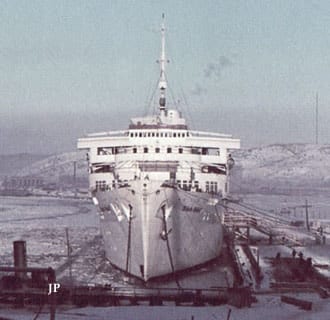 When the Gustloff left the relative protection of the harbor at Gotenhafenon on January 30th, 1945, the weather was very poor; wind strength of 7, it was snowing, the temperature was 10 degrees below zero, and ice flows were in the water. Any chance of survival once in the water in weather like this was next to impossible. Under its own power, the Wilhelm Gustloff began to punch its way through the choppy, blustery Baltic Sea, un-escorted against the threat of submarine attacks, with its only protection being the few anti-aircraft guns it had onboard to protect against air attack. Against the deadly submarine, the Gustloff was naked. According to the ship’s own records, the list of passengers on the 30th included 918 Naval officers and men, 173 crew,373 members of the Woman’s Naval Auxiliary units, 162 wounded, and4,424 refugees, for an official total of 6,050 people. This is according to the official list though and doesn’t take into account the many hundreds of other people that one way or another, were able to make their way onto the seemingly safe decks of the Gustloff. In fact, new research has now shown that the total number of people on the Gustloff at the time it was sunk was actually 10,582! Newly published research by Heinz Schon has set the number of people on the Gustloff as follows:8,956 refugees, 918 officers NCOs, and men of the 2.Unterseeboot-Lehrdivision, 373 female naval auxiliary helpers,173 naval armed forces auxiliaries, and 162 heavily wounded soldiers, for a total of 10,582 people on board on January 30th. Then, at 2108 01.30.45, (9:08 pm, January 30th, 1945 Gotenhafen time; 7:08 pm Moscow time; 2:08 pm Milwaukee, WI, USA time), the Soviet sub S-13, commanded by Alexander Marinesko, hit the Gustloff with a spread of three torpedoes. The Gustloff immediately leaned to starboard, righted itself, and then leaned to again. She then launched rescue flares and broadcast an SOS. According to an eye-witness account of Oberbootsmannsmatt Karl Hoffman, the first torpedo struck the Gustloff at the bow, directly below the helm deep below the waterline. The second torpedo exploded under the area of the ship that was the swimming pool, and the third torpedo hit amidship in the forward part of the engine room, ripping the ship hull and shattering the machinery. Soon, the forecastle was nearly underwater, with the stern beginning to rise above the waterline. In under 50 minutes’ time, the Gustloff was gone, taken beneath the icy black waters of the Baltic, and with her, 9,343 men, women, and children. Amazingly, 1,239 people were saved by the heroic and selfless work of a number of German ships in the area. Torpedo boat T-36 rescued 564 people, Torpedoboot Löwe 472 people, Minensuchboot M387 98 people, Minensuchboot M375 43 people, Minensuchboot M341 37 people, steamer Gottingen saved 28 people, Torpedofangboot TF19 saved 7, freighter Gotland 2 people, and Vorpostenboot 1703 saved one person, a 1-year-old child. 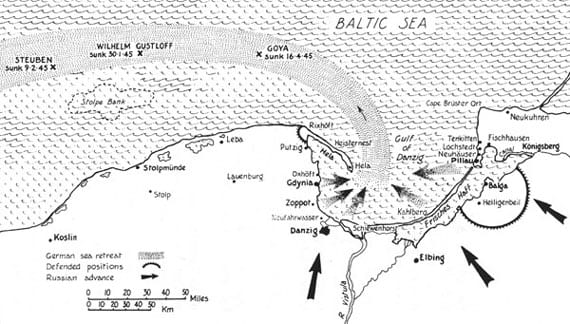 When the Gustloff sank it was an event unlike any in naval history, if for no other reason, because of the sheer scale of the tragedy. Many ships have sunk with the horrible loss of life, but never have so many lives been lost with a single ship. Like all naval tragedies, the scene was one of sheer and complete horror. The suffering of those on the Gusltoff was unspeakable, it transcends all time and place, all nationality, and all borders. It was a terrifying loss of human life and one that few know of today. In 1955, a German film called “Nacht fiel über Gotenhafen” was released that portrayed the final voyage of the Gustloff, a film that is both very accurate and a very touching tribute to those lost at sea. Lastly, of the very few books on the Gustloff, a recently-published book by Heinz Schon called “SOS Wilhelm Gustloff – Diegrösste Schiffekatastrophe der Geschicte” is now considered to be the definitive work on the sinking and the previous history of the ship. 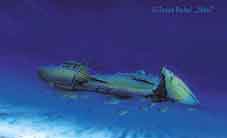  What is now left of the Wilhelm Gustloff is a broken wreck designated officially as a gravesite and off-limits to most divers. The bow and stern of the ship are well preserved while the mid-section is heavily damaged and crushed in upon itself. We shall always remember those lost with Gustloff. May they rest in peace. |


